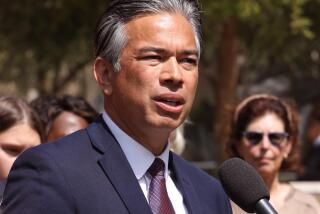FBI Easing Policy on When to Shoot : Crime: Agents would be permitted to fire at fleeing suspects they believe have killed someone. Some see plan as a bad example for other police agencies.
- Share via
WASHINGTON — The FBI--long a voice of restraint in police use of deadly force--is changing its policy to permit agents to fire at suspects fleeing from crimes in which they are believed to have killed or seriously injured another or attempted to do so, it was learned Tuesday.
The new policy would also allow shooting at a fleeing suspect who is believed to be armed and has a history of killing or attempting to kill, government sources said.
The shift from a standard that permitted agents to fire only in self-defense or to protect innocent people from death or serious injury occurs as police officers are facing mounting danger, particularly in drug cases, supporters of the policy noted.
FBI Director William S. Sessions signed off on the new policy only after sharp debate inside the agency, where opponents contended that the looser standard would subject the bureau to intense criticism and set a dangerous example for police departments in which officers get less training than FBI agents, according to the sources.
Bob Davenport, the FBI’s chief spokesman, refused to confirm or deny the policy shift, but sources familiar with it provided the details on condition that they not be named.
The broader discretion is being extended to agents just as the FBI is changing its issued weapons from .38-caliber revolvers to 10-millimeter semiautomatic pistols capable of firing more rounds faster.
The new policy, which has yet to be disseminated to agents in the field, will also permit agents to fire warning shots if that can be done without risk to innocent people.
A spokesman for Atty. Gen. Dick Thornburgh, who is traveling in Europe, said: “That proposal has not come to the attorney general’s office.”
When asked if he was suggesting that department officials have reservations about the new policy, spokesman Dan Eramian said: “I can’t comment one way or another.” Thornburgh could order the policy reversed.
Rep. Don Edwards (D-San Jose), chairman of the House Judiciary subcommittee on civil and constitutional rights, which watches over the FBI, said that he hopes the bureau will re-examine the new policy. “I’m not at all sure it’s a good idea,” he said.
Edwards stressed the FBI’s status as a role model for smaller police agencies in expressing his doubts about the shift. “The FBI is looked upon as the model police agency of the world--the elite,” he said.
The current, more restrictive standard “seems to be a responsible one,” Edwards said. “If a few people are not captured or shot, I don’t think the crime wave will get out of control.” But a bureau source who supports the new policy said that it has been made necessary by “the increased exposure and incidents of shootings that our special agents are encountering on the street and the amount of danger they are exposed to. There’s no question that it’s drugs.”
At the same time, the source conceded being concerned “from a leadership point of view. In the hands of a highly trained law enforcement officer, the policy is appropriate,” he said. “But for a police officer with minimum training who is confronted with a complex situation,” it’s a different story.
James J. Fyfe, a former New York City police lieutenant who now teaches police and law enforcement at American University here and frequently serves as an expert witness in police shooting cases, said he was “sorry to see the change. The bureau’s example was very important.”
Fyfe said that he is surprised that the FBI plans to permit warning shots when pursuing persons suspected of killing or seriously injuring others.
“What goes up must come down,” Fyfe said of warning shots, adding that he knows of cases in which police officers fired shots unjustifiably, then claimed that they were warning shots.
“The only big municipal (police) department that permits warning shots is San Jose,” he said.
In permitting warning shots, the bureau’s policy, which until now has been “shoot to kill,” provides that the warning fire must not constitute risk to an innocent person, such as a bystander watching from a second-floor window.
Both present and incoming agents will be given “a very rigorous block of new training” to carry out their broader discretion, a federal law enforcement source said.
The new policy is in line with the March 27, 1985, ruling by the Supreme Court that struck down as unconstitutional a Tennessee law authorizing police to use “all necessary means” to apprehend escaping suspects.
In that ruling, the court said also: “If the suspect threatens the officer with a weapon or there is probable cause to believe that he has committed a crime involving the infliction or threatened infliction of serious physical harm, deadly force may be used if necessary to prevent escape and if, where feasible, some warning has been given.”
Sources familiar with the policy shift attributed it in part to the April 11, 1986, shoot-out near Miami in which two FBI agents were slain and five were wounded, along with two heavily armed bank robbery suspects.
In that incident, FBI agent Edmundo Mireles Jr., despite serious wounds, dragged himself to an automobile and killed both suspects. Mireles, who took a year to recover from his wounds, received a Justice Department award and in April became the first recipient of the FBI’s medal of valor.
But sources familiar with the incident said that Mireles may have technically violated the FBI’s policy that shots are to be fired only in self-defense. By the time Mireles reached the suspects’ car, they had stopped shooting.
More to Read
Sign up for Essential California
The most important California stories and recommendations in your inbox every morning.
You may occasionally receive promotional content from the Los Angeles Times.












